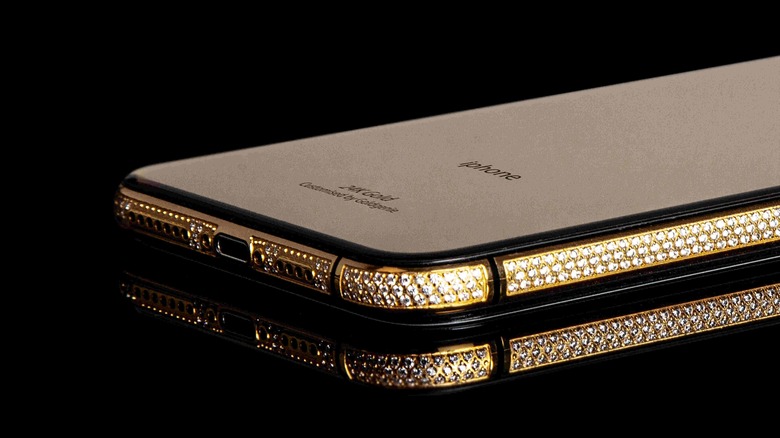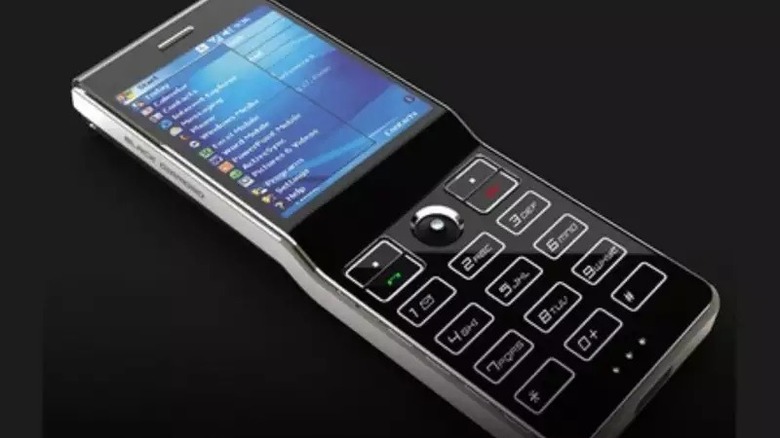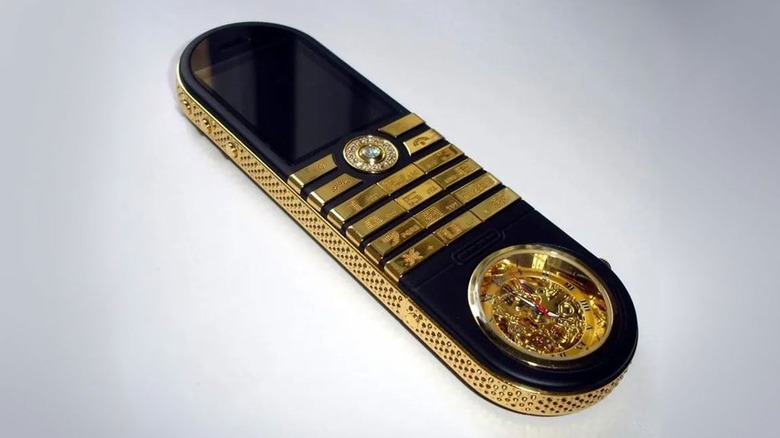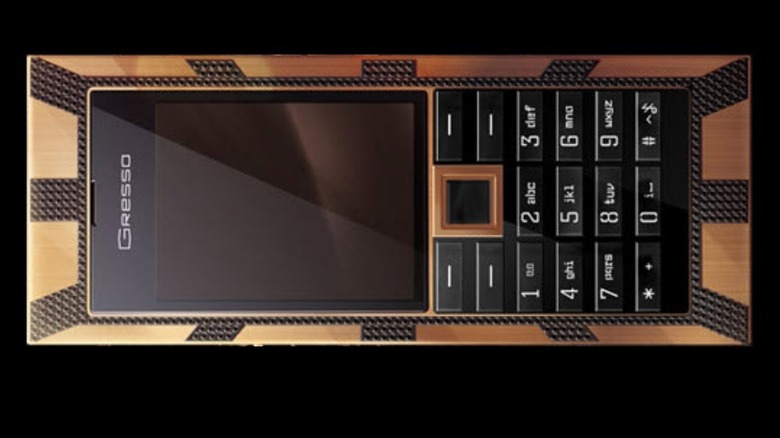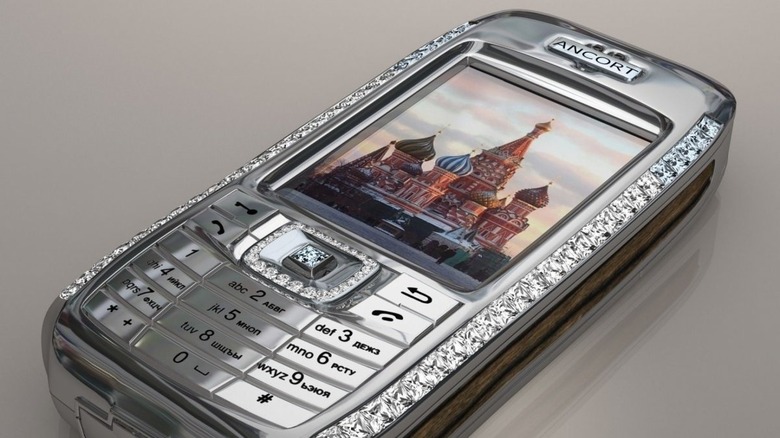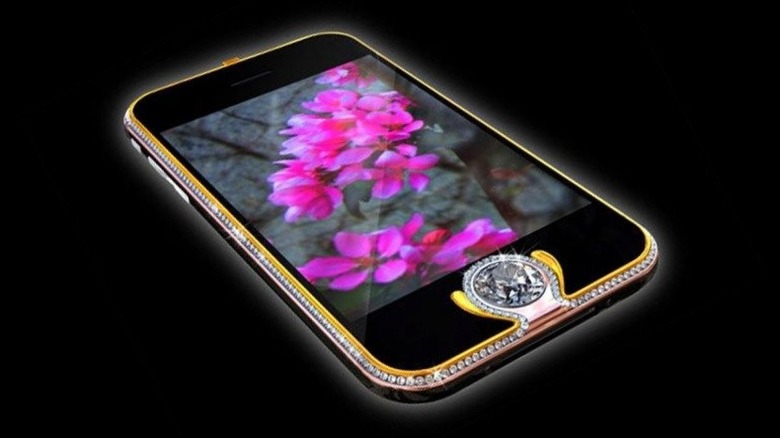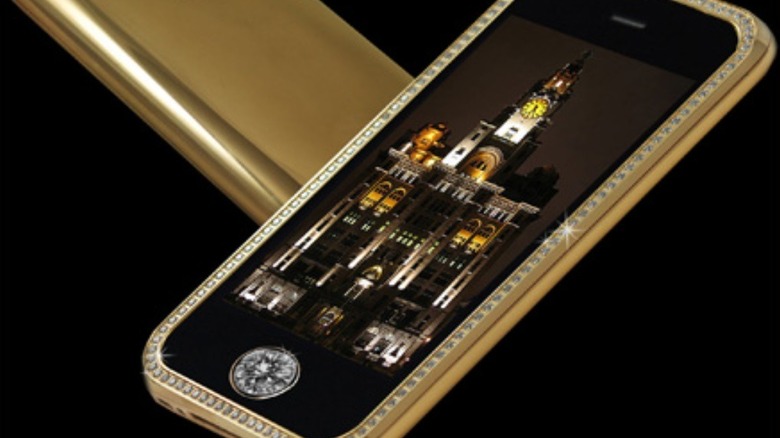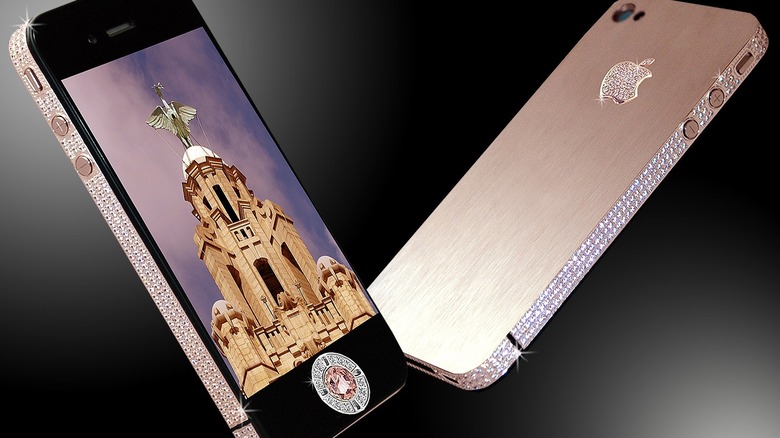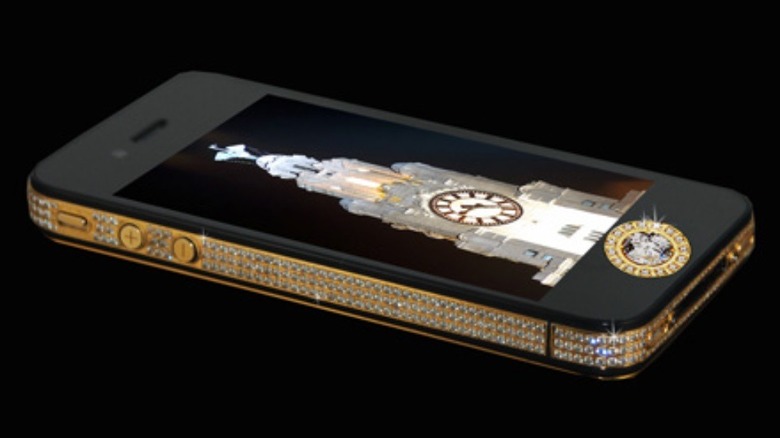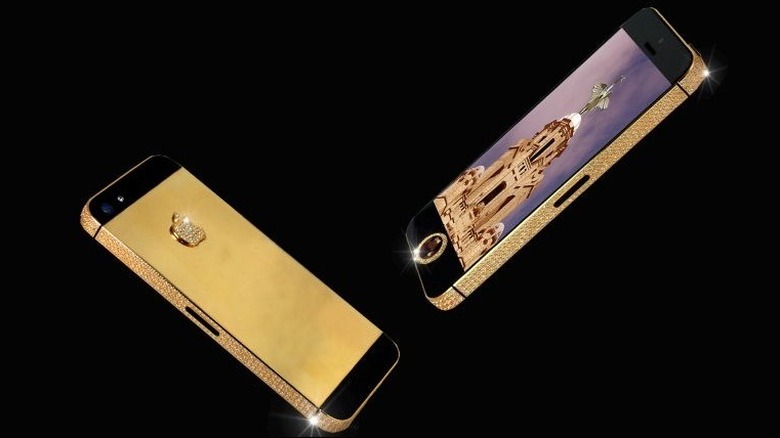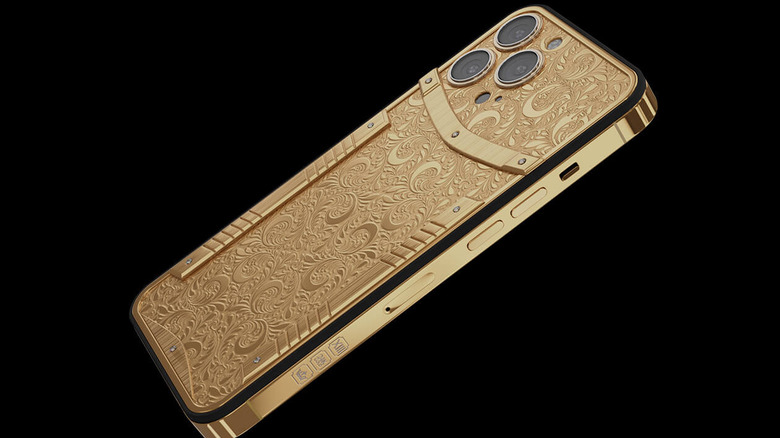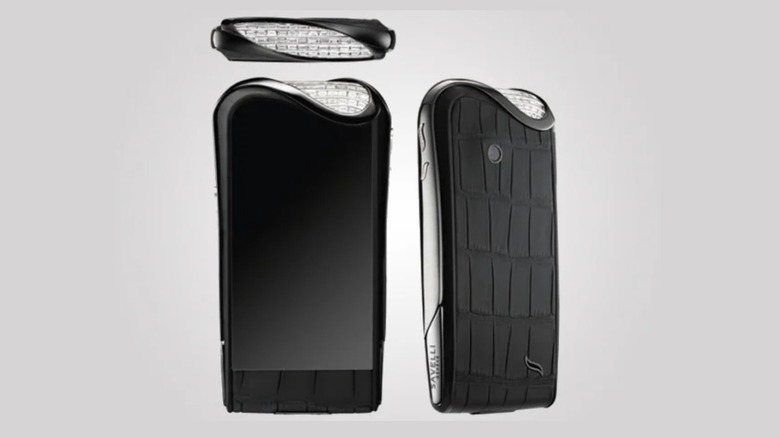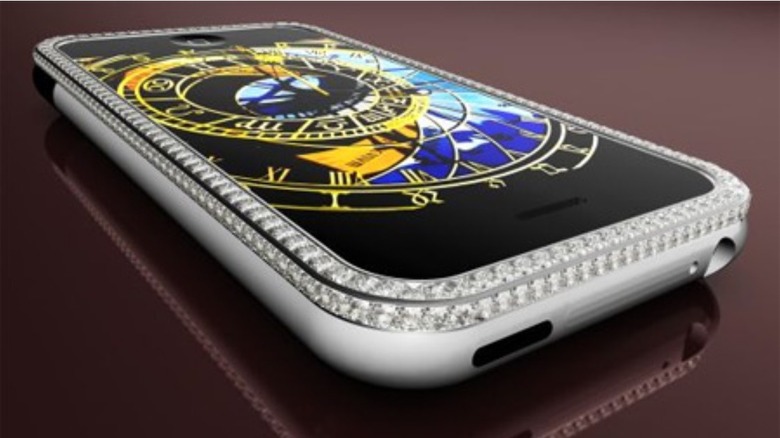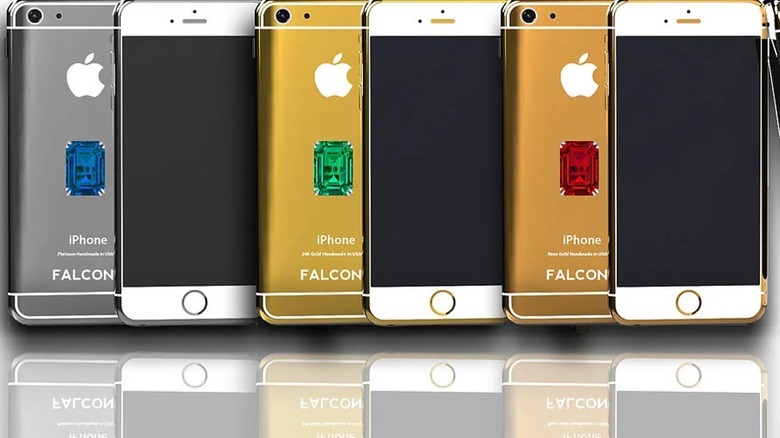The 10 Most Expensive Smartphones In The World
Our smartphones keep getting fancier and fancier every single year. New features, longer battery life, better cameras, and faster connections have driven the cost of a new smartphone through the roof. It's gotten so bad that the average person has to finance their device over a couple of years just to avoid breaking the bank.
Recently, Samsung crested a new price point threshold with the release of their Galaxy Fold slate of phones, most of which come in just under two thousand dollars before taxes. To be fair, it's less a phone and more a full-sized tablet you can crack in half and shove in your pocket. Owning the latest — and usually most expensive—smartphone has become something of a status symbol, wordlessly signaling to everyone around you that you keep up on the latest mobile technology and have the means to acquire it. Either that, or your last phone broke, and you had no choice but to replace it.
Still, two grand is a hefty price to pay for a phone, at least if you're an average person. The world's wealthy elite, however, shop at different stores than the rest of us and the price tags on some of their phones are out of this world. The numbers start high, and they only get higher.
Sony Ericsson Black Diamond
Sony Ericsson isn't a name you're likely to hear bandied about the mobile phone shop these days, but in the early 2000s they were a common sight on store shelves and in consumer pockets. For a while they even housed the contemporary version of Sony's famed Walkman technology, (per Gadgets 360).
In 2006, Sony got in on the premiere phone game with the release of the Ericsson Black Diamond, (per Gizbot). Even by today's standards, the phone is admittedly pretty cool looking. The top half is dominated by a screen while the bottom half is recessed and reserved for the number keys. The effect is a phone which looks bent at the middle, giving it a simultaneously dated and futuristic look.
Otherwise, there's nothing all that special about the phone itself. The specs were pretty standard, and it wasn't made of any precious metals, aside from those you'd find inside any phone of the time. As explained by Trendhunter, production was limited to only five units per year at the time of release.
All things considered, the only real value in the phone was its rarity. We're not sure if that justifies it's $300,000 cost, but sometimes when you're rich the price tag is the point.
GoldVish Revolution
The Revolution, by Goldvish, would look like any other phone you might have picked up at a mall kiosk in the late-90s or early 2000s if it weren't for a few key features. Its slim shell was punctuated by an ostentatious analog watch below the push-button keys. That feature feels superfluous considering that the phone's screen undoubtedly displayed the time, just like every cell phone since the beginning of time, but it was there in case you wanted it.
The watch was just a cherry on top of a diamond-encrusted sundae. As explained by Phone Arena, the parts of the Revolution which weren't molded plastic were covered in 18-carat pink and white gold. That might have been fancy enough even without all the gemstones.
The outside edge of the phone, the numbers and symbols on each of its sixteen buttons, as well as the central navigation toggle, were encrusted with a total of 29 carats in diamonds. Again, a limited production run was part of the appeal, with only nine units ever made, each of which retailed at $490,000, (perLuxuo).
Gresso's Luxor Las Vegas Jackpot
If you thought the price tags on the first two phones were disgusting, prepare your barf bag because we're about to level up.
It was only a matter of time before we hit seven digits and we got there with the Luxor Las Vegas Jackpot. Only three of these phones were produced, adding the Jackpot to the list of exclusive luxury devices. In exchange for one million U.S. dollars, (per ZDNet) the buyer was handed a jumbled collection of precious materials which were never meant to share the same space.
The Jackpot's backing was made of 200-year-old African Blackwood, which is an exotic wood, but you can buy a decent-sized piece of it for about ten bucks online. It's curious the wood was even mentioned as a selling point when the rest of the phone's exterior is impressive enough.
As explained by GSM Arena, the phone's frame was made of 180 grams of gold and broken by a starburst pattern of tiny black diamonds, total 45.5 carats. If that weren't enough, each of its 17 buttons were carved from sapphires and laser etched with their respective numbers and symbols.
If you were feeling especially frugal but still wanted to be fancy, Gresso offered a paired-down version of the Jackpot, lacking all of the precious gemstones, for a measly $200,000. What a steal.
Diamond Crypto Smartphone
If you're the sort of person likely to shop for a seven-figure phone, your primary concern is likely how to acquire even more money. However, what good is an ungodly bank balance if you can't protect it? That's where the Diamond Crypto came in.
This phone isn't just a flashy showpiece, though it certainly is that. It also promised to protect all of its wealthy owner's important information. Designed by the Russian firm JSC Ancort, (per Engadget), and blinged-out by Peter Aloisson—famous for sticking diamonds on anything and everything—the Crypto promised powerful encryption and security to protect against digital attacks. It also promised to turn every head any time you pulled it out to make a call.
The sides of the phone and its central navigation button were lined with 40 white diamonds and 10 blue ones, which accounted for most of the phone's $1.3 million cost. In a world where cell phones become dated almost the moment you walk out of the store with them, we can't imagine dropping that kind of cash on what is essentially a Windows-based Blackberry.
iPhone 3G King's Button
Have you ever wanted to spend $2.5 million on a machine you'll use to look at memes and argue with people on the internet? Silly question, who hasn't? If you'd had that kind of extra cash burning a hole in your pocket in 2009, then there was the perfect phone for you.
Peter Aloisson was at it again, one-upping his previous work on the Crytpo. By this point, the iPhone had arrived on the scene and changed the cell phone game forever. Now there weren't any number keys to encrust and it's hard to stick diamonds on a touchscreen, so Aloisson had to get creative.
As explained by New Atlas, the shell of the phone was made of 18-carat yellow, white, and rose gold and sprinkled with 138 diamonds lining the border between shell and screen. The crown jewel, literally, was a single 6.6-carat diamond in place of the iPhone's 3G's home key.
What's $2.5 million in exchange for the chance to feel like you're stealing a gem from the cave of wonders every time you open up your phone's menu? If you bought one, we hope you got the most out of your Indiana Jones fantasies because inside the sparkling exterior was an ordinary iPhone 3G, which at this point is little more than a diamond-encrusted paperweight.
Goldstriker iPhone 3GS Supreme
If you've never heard the name Stuart Hughes, get ready for that to change. Hughes cornered the market on ridiculously over-the-top phones for a while. There was a time when he sat atop a small pile of jewel-encrusted iPhones like a dragon with a very specific hoarding obsession. Luckily for you—well, probably not you, but the mega-rich—he was willing to part with them for a price.
Hughes's first entry on this list was the iPhone 3GS Supreme, which retailed at £1,920,000.00 (a little more than $2.5 million, at the time of this writing). It's similar, both in design and bling factor to the King's button, but Hughes was just getting started.
The phone's shell was made of 22 carats of gold and had a line of 136 diamonds running around its exterior. Like the King's button, the home key was replaced with a single large diamond, weighing in at 7.1 carats, (per Stuart Hughes).
Of course, you can't own a treasure like this without having an appropriate chest to keep it in. Your iPhone 3GS Supreme came stored in a 15-pound block of granite, with leather lining. We're not sure what you're supposed to do with a stone box after you take the phone out, but you paid for it and it's yours.
iPhone 4 Diamond Rose Edition
New iPhone, new "world's most expensive phone." As the iPhone's design changed slightly, Hughes's had to change with it. The iPhone 4 took its screen to the edge, pushing out the favored home of smartphone diamonds. Ever the adaptive designer, Hughes moved the diamond collection to the sides and shoved a whole bunch more in there.
According to Stuart Hughes, The Diamond Rose had roughly three times as many diamonds as its predecessor, clocking in at approximately 500 in total. The back of the phone was made from rose gold, giving the Diamond Rose edition its name, and the Apple logo sparkled with its own diamond coating.
Once again, the home button was replaced by one large pink diamond. This time it was even larger, coming in at 7.4 carats, with the option to replace it with an 8-carat diamond. Just like before, it came delivered in a box of cut granite. Inside, the Diamond Rose boasted 32GB of internal storage, which sounds like a joke when compared with today's smartphones but was the best the iPhone 4 had to offer.
Only two Diamond Rose phones were produced, and they sold for £5,000,000.00, or approximately $6.5 million.
iPhone 4S Elite Gold
Stuart Hughes came back with another luxury phone, in the shape of the iPhone 4S Elite Gold. The overall design of the 4S Elite is similar to Hughes's previous phones. In terms of functionality, it was just a standard iPhone 4S with 64GB of internal storage. At least they sprung for the highest internal storage. If you're paying £6,000,000.00, or approximately $7.8 million, you deserve to at least not run out of space for your favorite podcasts.The case of the 4S Elite was made of 24-carat gold, including a gold Apple logo covered in 53 diamonds, (per Stuart Hughes).
The entire phone was bordered in more than 500 diamonds. Only two were ever produced but each of them was a complete jewel heist all on their own and that's before we even get to the home key.
In place of the iPhone 4S's standard home button, Hughes locked down a single 8.6-carat diamond. As with the previous phone, it could be customized. Buyers had the option of swapping it out for a 7.4-carat pink diamond.
The major change from Hughes's previous offerings was the chest it came in. Instead of a piece of cut granite, the 4S Elite came in a platinum box, decorated with rare stones and pieces of cut T. rex bones, meaning the Elite was a phone 66-million-years in the making.
Black Diamond iPhone
By this point, Stuart Hughes had made a name for himself as the patron saint of getting weird with phones and shiny rocks and it was time for his magnum opus. He was contacted by an unnamed Chinese businessman and asked to craft a custom luxury iPhone 5.
The customer only had one request, he wanted Hughes to incorporate a 26-carat black diamond into the design, (per PC Mag). Knowing Hughes, he had the perfect place for that honker of a gemstone, right where he put every other massive diamond. With the home button sorted, Hughes went about blinging out the rest of the phone in the usual way.
The perimeter of the phone was coated in 600 white diamonds with an additional 53 making up the Apple logo on the back. All told, the phone was valued at $15 million, with $14.5 million of that value coming from the centerpiece black diamond, (per CNN).
Since this was a customer job commissioned by an individual, it wasn't available to the general public (even the subset with $15 million to burn) but Hughes did make a simplified version for the normies. For about $4,000 you could get a solid gold iPhone 5, without all the diamonds. Given how often we drop our phones, we're not sure coating them in precious metals is the right move, but to each their own.
Honorable mention - Caviar iPhone 13 Pro Victory Pure Gold
The name of this phone is admittedly a mouthful but it's positively affordable when compared with the other phones on this list. Looking at the early days of luxury smartphones, it seemed like the philosophy was to always add more. More gemstones, more rare materials, luxury was synonymous with excess. The Caviar Victory Pure Gold shows there is another way.
The phone's shell is made of 170 grams of 18-carat gold on the Pro, and 205 grams on the Pro Max, (per Caviar). Instead of covering it in hundreds of diamonds, the gold has been engraved with an artistic design. Of course, there are still diamonds, but only eight of them. Instead of being the centerpiece of this phone, the diamonds serve as accent pieces, complementing the swirling design of the gold case.
Ninety-nine of these phones were produced and each one comes with an engraving on the side which indicates your phone's number within the run. The Caviar Victory Pure Gold starts at $44,720 and the price goes up slightly (relatively speaking) depending on which model and storage size you choose. If you're going to spend tens of thousands of dollars on a phone, you might as well spring for the Pro Max with 1 terabyte of storage, for $49,190.
Honorable mention - Savelli Black Insane
Savelli set out to design luxury phones specifically for women, (per Luxury Launches). As far as we can tell, that means designing phones with curved exteriors, soft colors, and "feminine shapes," because at the end of the day a phone is a phone.
Their collection was made of 11 models with prices ranging from $9,000 to over $100,000. The collection's signature model was the Black Insane. True, spending six figures on a phone might sound like an unhinged decision on the surface, but after seeing some of the other phones that are out there, it seems almost frugal.
At a cost of roughly $115,000, the Black Insane was made of stainless steel and black ceramic. It was encrusted with 75 white diamonds and encased in alligator leather, (per Luxury Launches). You weren't likely to find these phones at your local AT&T or T-Mobile. If you wanted to get one, you had to make a trip to one of a couple jewelry retailers in London or Paris.
The added expense of a plane ticket and a hotel stay is just the cost of doing business when you want a luxury cell phone from Savelli.
Honorable mention - iPhone Princess Plus
Prepare for the triumphant return of Peter Aloisson, the mind behind the Crypto and King's Button. In 2007, he set his sights on another iPhone and created the Princess Plus. Pre-orders started in October 2007 with delivery set for January of the following year, (per Luxury Launches).
As explained by Mobile Tor, the phone was surrounded by a border of 318 individually cut diamonds, 138 of which were princess cut. The diamonds weighed in at 17.75 carats in total and were set in an 18-carat white gold shell.
Unlike the other luxury iPhones on this list there was no massive diamond replacing the home key but that's where most of the expense typically came from, which is why you could get your hands on the Princess Plus for the totally reasonable price of $176,000.
If that was a little over your phone budget, there was also a version which cut out the princess cut diamonds, replacing them with brilliant cut, reducing the cost to about $66,000. What a steal!
Grand finale - Falcon Supernova iPhone 6 Pink Diamond
We reached peak phone flamboyance in 2014 with the announcement of the Falcon Supernova iPhone. Gone are the gauche piles of hundreds of diamonds tacked to every available surface. This phone was intended for only the classiest of show offs, the mega-rich who want to cosplay as normal until you look closely enough.
The Falcon Supernova looked like a normal iPhone from the front, and mostly it was. As explained by CNET, the phone was plated in gold, but you could almost miss that if you didn't know any better. It's not until you flip the phone over that you realize what's really going on.
On the back of the phone, you'll find a single diamond so massive, you might get pulled into orbit around it. Getting one would cost you $48,500,000, but that's a small price to pay for a phone with a literal infinity stone embedded in its case.
It's difficult to imagine how anyone can exceed the cost or extravagance of the Falcon Supernova, but given enough time we're certain someone will do it.
